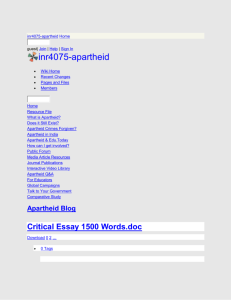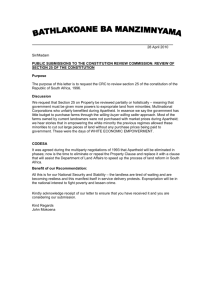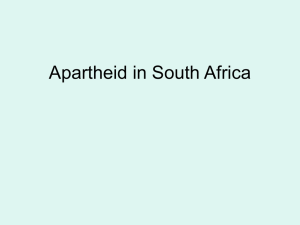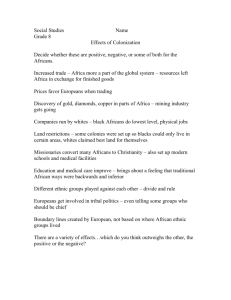1913 Natives Land Act - Parliament of South Africa
advertisement
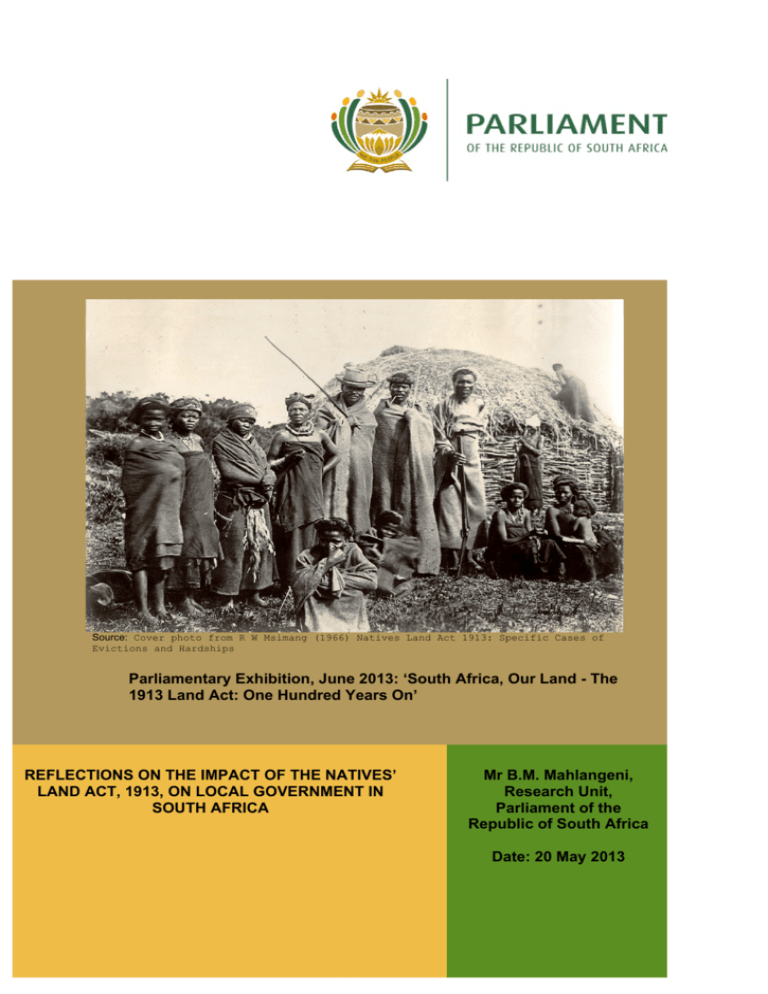
Source: Cover photo from R W Msimang (1966) Natives Land Act 1913: Specific Cases of Evictions and Hardships Parliamentary Exhibition, June 2013: ‘South Africa, Our Land - The 1913 Land Act: One Hundred Years On’ REFLECTIONS ON THE IMPACT OF THE NATIVES’ LAND ACT, 1913, ON LOCAL GOVERNMENT IN SOUTH AFRICA Mr B.M. Mahlangeni, Research Unit, Parliament of the Republic of South Africa Date: 20 May 2013 REFLECTIONS ON THE IMPACT OF THE NATIVES’ LAND ACT, 1913, ON LOCAL GOVERNMENT IN SOUTH AFRICA 1. INTRODUCTION The Natives’ Land Act, 1913 (Act No. 27 of 1913) right from its inception to date, continues to have devastating consequences and negative effects on the development of local government. The Act perpetuated and reinforced the racially discriminatory foundation of local government. The subsequent land policy measures and regulations and other laws passed in the following years, were intended to ensure the smooth implementation of the Land Act. Thus even before the National Party introduced a system of apartheid and separate development in 1948, the Land Act was already a piece of legislation that paved the way for the disastrous path of the current under-development in the country; especially at the local government level and predominantly in the former homelands.1 The manifestations of the ravages of the 1913 Land Act are prevalent and strongly felt at the local government level. The Act enabled the South African local government of the time and then during the later apartheid period, to become the main theatre of apartheid implementation as can be witnessed in the separate amenities, services and residential areas for the different racial groups during the apartheid era. A system of local government and administration, under apartheid, entrenched separate development and the balkanisation of the South African state into different ‘native reserves.’ The majority of the South African population, which was predominantly African, was regarded as sojourners in the towns and cities. This paper reflects on the manifestations of the Land Act, 1913, at the local government level and the damage it caused in perpetuating under-development and a system of unequal and separate services and amenities for the different racial groups. The African population was not treated as an integral part of the country’s citizenry but as mere second class citizens whose role was mainly to provide cheap labour for the White business elite and the mines through a migrant labour system. 2. BACKGROUND The Natives’ Land Act, 1913, which was subsequently renamed the Bantu Land Act, 1913 and the Black Land Act, 1913 (Act No. 27 of 1913) was an Act of Parliament by the then Union Government which was aimed at regulating the acquisition of land by “natives”; the term then used to refer to Africans . It was the first major piece of segregation legislation passed by the Union Parliament. It remained a cornerstone of apartheid until the 1990s when it was replaced by the 1 Also known as ‘Bantustans’, the homelands were supposedly politically autonomous territories set aside for Africans which were meant to provide the ideological justification for apartheid - South African History Online (Undated). 2 current policy of land restitution2 and which by itself is not yielding the desired results.3 The Natives Land Act, 1913 is of importance for both legal and historical reasons.4 It is the single most important apartheid legislative instrumentthat resulted in the present under-development of the country especially in the former African-designated areas; then known as the homelands. The Act created a system of land tenure that deprived the majority of South Africans the right to own land. It was accompanied by major socio-economic repercussions and, it was meant to perpetuate land dispossession on the part of the African majority. There is an argument that had the Supreme Court not rendered the Act’s application void for a few years, it would also have disenfranchised all “natives” in the Cape Colony, where Africans and Coloureds had greater political rights than the other provinces; a legacy of British rule.5 3. REFLECTIONS ON THE IMPACT AND EFFECTS OF THE LAND ACT IN LOCAL GOVERNMENT From the inception of the Union of South Africa, up to the end of National Party rule, the country had a system of local government based on racial discrimination. The Land Act, together with subsequent legislation, effectively reserved 87% of the country for Whites. In the area of local government, the legislation acted as a forerunner to other policy and legislative measures which culminated in separate residential areas for the different racial groups during the apartheid era. Urban areas were declared the preserve of Whites. Blacks were required to have permits allowing them to reside in towns only during a period prescribed in accordance with the purpose for which it was issued, for example, the employment contract period.6 The Land Act led to the passage of the Group Areas Act, 1950 which enabled the implementation of land use management practices and disposal arrangements that favoured the development needs of the white population group. This further led to the development of major affluent residential areas for the whites with good quality services, whilst little or no formal residential development was developed for Blacks, resulting in the proliferation of informal settlements and shack-dwellers without access to basic services such as clean running water, sanitation and refuse removal.7 If ever a residential area for Africans had to be developed, the local government authorities made sure that it was a township situated some distance from white urban areas, so that the government at the time could perpetuate the notion that the urban areas were indeed exclusively or even predominantly white enclaves – in stark contrast to the actual reality. Africans could only legally own land in the rural areas under a system which required them to apply for permission to occupy land. This deprived them of the right to use it as security 2 Restitution of Land Rights Act (1994). Nkwinti (2012); Department of Rural Development and Land Reform (2012). 4 Natives Land Act (1913). 5 Fourie (2000). 6 Ibid. 7 Ibid. 3 3 against loans needed for further development.8 Further, Africans were only allowed as temporary residents in the cities and towns which were designated for whites. Coloureds and Indians had separate residential areas and even today, South Africa’s population patterns and their geographic spread is race-based – a legacy of the Land Act and other racially discriminatory legislation. There are areas which have now virtually become enclaves for amaZulu, amaXhosa, Tswanas, Sotho speaking, Venda, Ndebele, Shangan,Tsonga and Bapedi groups. From the 1950s onwards, Whites, Coloureds and Indians had to live in their own race group areas, with Whites having the largest amount and generally the best located land.9 The fact that so little land was available for African occupation in general, meant that large informal settlements, known as squatter settlements, developed in and around most towns and cities. To date, South Africa’s major towns and cities, especially the main metropolitan cities are the areas which mostly attract informal settlements or shacks within their jurisdictional areas. The upgrading of these settlements, both in terms of services and titles, poses a major cadastral or land information system challenge. The policy of apartheid and separate land development objectives for the different racial groups meant that the formal housing stock was not planned for the whole population, a situation which created severe housing shortages in the towns.10 Current research and debate on these issues reflects that it was in fact imprudent not to provide for the entire populace in an integrated manner.11 As a result, cities are still grappling with the legacy of the draconian land policies and subsequent apartheid legislative instruments that sought to entrench the division of the country according to the racial groups while the Whites remained a dominant, well served section of the South African population. During the apartheid era, there were separate local government institutions and bodies established for the different racial groups which were operated in a manner which discriminated against the Black majority (i.e. Africans, Coloureds and Indians) and in whose decision making they were not allowed to participate. Africans in particular had little or no voice in their own development and any kind of development was mostly imposed development; the government’s development thinking was mainly top-down. They were reduced to passive spectators. Local government delivery practices usually demand that bulk land be readily and abundantly available as opposed to piecemeal allocation and ceding of land for particular development. Such practices stifle pro-active planning approaches by encouraging and promoting a reactive approach to development. Whilst the Land Act had major implications for land delivery systems in the country, the 13% reserved for Africans had special land delivery procedures known as Proclamation R293 of 1962 for proclaimed urban areas and R188 of 1969 for rural areas.12 The 8 Fourie (2000). Ibid. 10 Wallace (2013). 11 Fourie (2000). 12 Fourie (2000). 9 4 homelands that opted for a nominally independent status had their own versions of Proclamation R293. Currently, there are various provincial planning ordinances that are applied differently in the different provinces in the same country, a situation which slows down development and instead promotes a pattern of development which reflects the former colonial and apartheid way of thinking, many years after the current constitutional order was established in 1994. Local government under apartheid displaced many people in terms of ancestral land under the guise of development and without any compensation. Areas that were formerly occupied by other racial groups but seen as desirable for White occupation were simply taken over for White-owned development projects. For example, many Coloured citizens lost their land in Cape Town, with District 6 being a case in point.13 Notwithstanding this example, the scale of removal of Africans far out-stripped the effects on other race groups.14 Even though the apartheid planners did not want Africans to be part of the South African state, they did want them to work in the cities, a situation which resulted in the allocation of large urban areas as urban African townships to enable migrant workers to commute to work, undertaking long distances of approximately 180km, which were considered normal for Africans to travel.15 Typical examples of these large townships are Mdantsane in the Eastern Cape, Soweto in Gauteng, Umlazi and kwaMashu in kwaZulu-Natal. During the colonial era, most Africans were excluded from living in the most developed areas in the Orange Free State, Natal and the Transvaal. Urban areas or towns and cities were generally viewed as not for Africans. The application of this prohibitive measure varied from province to province. For example, in Natal, a general view was held that Africans need to understand that the towns of the Colony were the special places of abode for the white men, who are the governing race.16 In the Cape, Africans were generally not allowed to live in or near towns without special permission and in 1899 they were even prohibited from walking on sidewalks.17 In the Free State, the traditional conception of native locations was merely a convenient reservoir for the purpose of supplying the legitimate labour requirements for white towns and villages, with strict curfew laws.18 The Urban Bantu Councils Act, 1961, formed part of other policy instruments that gave strength to the 1913 Land Act.19 It formed part of the framework of apartheid racial segregation. It replaced the Advisory Boards created earlier by the Natives Urban Areas Act of 1923.20 It permitted the democratic election of new municipal 13 Ibid. Ibid. 15 Ibid. 16 Wallace (2013). 17 Ibid. 18 Ibid. 19 Urban Bantu Councils Act (1961). 20 Native Urban Areas Act (1923). 14 5 councils with an African Chairman assigned some administrative duties. Rapid urbanisation of Africans was regarded as the ultimate threat to white supremacy. The Black Local Authorities Act, 1982 provided for the establishment of a series of local government structures similar to those operating in the White urban areas. With this legislation, and for the first time under apartheid, the African residents of urban locations gained some measure of autonomy. Although the Africans did not have access to Parliament, this legislation gave them some local township power (albeit strictly limited and racially-based) and was one of the strong pillars of apartheid.21 It succeeded the Native Affairs Act, 1920 and created a legal basis for the deportation of blacks into designated homeland reserve areas.22 Further, it established tribal, regional and territorial authorities. The National Party government developed the concept of allocating resources such as general infrastructure, education and jobs on a racial basis, and formalised it into law. Thus a piece of legislation called the Reservation of Separate Amenities Act, 1953 made provision for separate amenities such as toilets, parks and beaches for different racial groups. Subsequently, apartheid signs indicating which racial group was permitted to enter and use the facilities were displayed throughout the country. The standard and quality of amenities for all Black South Africans were generally lower or inferior to those meant for Whites, a situation which inculcated a mindset of superiority to this South African race group as generally everything the government did, was meant to serve and service their minority needs.23 The Colour Bar Act, 1926, prohibited Africans from doing any skilled work, this being a measure aimed at reserving jobs for Whites. This legislation was placed formally into law during the Pact Government from 1924 to 1928. It did to urban Africans what the 1913 Land Act did to rural Africans. It placed an almost absolute barrier to economic advancement for Africans, and advantaged Whites by eliminating competition from Africans.24 Local government is therefore one terrain where all apartheid laws were practiced and smoothly implemented. It is in the local government sphere and workplaces where job reservation was applied. This resulted in the lack of exposure experienced by Blacks from any skilled work and job areas which required technical skills and know-how. The Colour Bar Act culminated in the passage of the Reservation of Separate Amenities Act, 1953 which allowed public premises, vehicles and services to be segregated by race, even if equal facilities were not made available to all races. This perpetuated apartheid in local government spatial planning practices and land use patterns. It limited the capacity of local governments to enhance local economic growth and development beyond race and colour lines. 21 Black Local Authorities Act (1982). Native Affairs Act (1920). 23 Fourie (2000). 24 Colour Bar Act (1926). 22 6 The history of local government in South Africa is based upon an acceptance of racial discrimination and segregation in practice and culture, if not always in law. The historical norm in South Africa during the 20th century was one which, from the early years of the century, moved inexorably towards discriminatory land legislation and racial segregation, and subsequently under apartheid, the violent control of the ‘influx’ of African people into cities. Africans were barred from access to, and living in the so-called ‘White’ areas. All areas reserved for Black people were underdeveloped and characterised by poor service conditions as opposed to areas reserved for white people.25 In Black townships and urban locations, little attention was paid to everyday spatial needs. By contrast, in the ‘Whites only’ areas, these aspects received exaggerated attention, with parks, libraries, schools and public facilities abounding, often creating model environments not even found in more developed countries. Thus, local government was structured to facilitate and regulate an agenda of racial segregation and exclusion with each racial group afforded its own type of local government whilst the different types coincided spatially with the formal segregation of races in terms of the Natives Areas Act, 1923 and later the Group Areas Act, 1950. In a more practical and strict sense, it meant that the four designated racial groups, Coloureds, Indians, Whites and Africans had their own version of local government with varying capacities and powers.26 In summary, the apartheid government compelled South African cities to develop along unequal social, spatial and economic lines with Whites reaping most of the benefits and being more privileged than other race groups. In fact, the primary role of local government under the apartheid regime was to create and perpetuate local separation and inequality. It was never intended to be developmental. Any development was mainly oriented towards perpetuating white elitism in the areas of socio-economic life and prosperity.27 This is reflected in the then separate municipal institutions with different political and financial power bases. They were as such geared for the implementation of urban and rural apartheid. For the 1913 Land Act to be successfully implemented as part of the early history of conquest and dispossession, it needed a series of other policy measures and instruments. These measures included legislation detailed earlier in this paper, as well as laws such as the Group Areas Act, 1950 and the Reservation of Separate Amenities Act, 1953. Between 1913 up to the period before the National Party came into power in 1948, numerous policies were passed to entrench the position of Whites on all institutional fronts. According to the Medical Research Council of South Africa, before the transition to democracy in 1994, local government was based on apartheid racial divisions. As mentioned previously, land was not evenly 25 Beinart (1987). Cameron (1999). 27 Schensul (2009). 26 7 distributed and development was concentrated in certain areas around major metropolitan centres and mining industries.28 The apartheid city had a number of key characteristics. Firstly, environment, health and other administrative structures were duplicated for each race group and between local, provincial and national levels of government, a situation which resulted in fragmentation in terms of legislation, policy and programmes leading to inefficient and wasteful operations. For example, in the Cape Metropolitan Area (CMA), there were, prior to 1996, some 18-20 different local government administrative structures with little metro level co-ordination.29 Secondly, local government was unaccountable, with Black South Africans having no elected representatives. Service delivery was characterised by great inequalities in access between wellresourced White areas and poor rural communities. Therefore, historically and also in terms of local government, apartheid policies and legislation, of which the Land Act, 1913 is an integral part, paved the way for the current rural-urban divide. Apartheid fragmented the city in how and where the public sector delivered the goods and services.30 The vast majority of the people of this country remain landless and development continues to be concentrated in areas where there has always been appropriate infrastructure. By 2012, post-apartheid land reform had transferred 7.95 million hectares into black ownership, which is equivalent to 7.95% of formerly whiteowned land. Whites still own most of the country’s land, hence redressing racial imbalances in land ownership is land reform’s most urgent priority.31 Aliber et al assert that 45% of black South Africans want land as found in a comprehensive study of the demand for land carried out in 2005/06. They argue that one third of black South Africans want access to land for food production whilst another 12% want land for a variety of other reasons. Sixty six percent (66%) of this demand is from rural areas. Nearly half of the demand for land by black South Africans is from people between the ages of 18 and 34, and over one third is from people between the ages of 35 to 59. Almost half of black South Africans who want land would be satisfied with less than 1ha of arable land while a quarter would be happy with plots of 1-5ha.32 Given the above statistical information, it is clear that not enough state land is available to meet land reform targets. Official data contained in the work of Karin Kleinbooi and Alex Dubb in the PLAAS publication dealing with land reform reflects that only 2% of the total of 12.6million ha of state-owned land is suitable for land 28 Medical Research Council (1998). Nyalunga (2006). 30 Ibid. 31 Nkwinti (2012). 32 Aliber et. al. (2006). 29 8 reform.33 They argue that even if all 12.6million hectares of state land were distributed, it would meet only 50%of the land reform target.34 Land reform aims to redistribute 30% or 24.6 million ha, of privately owned commercial agriculture land. However, by 2011, it was estimated that only 6.2 million ha had been transferred through restitution claims and redistribution.35 4. SUMMARY AND CONCLUSION Something urgent has to be done to speedily reverse the legacy of the 1913 Land Act given the centuries of immense hardships suffered by all black South Africans. In response to the challenges of the 1913 Natives Land Act, the present government has drawn up a Green Paper on Land Reform, a Policy Framework for Land Acquisition and Land Valuation which introduces a four-tier Land Tenure System, for example, State and Public Land Leasehold Tenure; Privately owned land-Leasehold Tenure with limited extent; Land ownership by foreign nationals; Freehold but precarious tenure and Communal land-Communal Tenure with institutionalised use rights.36 Currently, there are three principles and strategic thrusts underlying the Land Tenure System in South Africa. The first one relates to the need to deracialise the rural economy whilst the second one is about democratic and equitable allocation and utilisation of land across race, gender and class. The third one entails the sustained production of discipline for food security.37 A Comprehensive Rural Development Plan currently in place lays emphasis on three phases, namely, meeting Basic Human Needs; Rural Enterprise Development and Agro-Industries sustained and supported by markets and credit facilities. Its programmes include Rural Town Revitalisation; Sustainable Rural Settlements; Rural Social and Economic Infrastructure and National Rural Youth Service Corps.38 According to Cloete, when the Union of South Africa was established, municipal affairs were made the responsibility of the provincial authorities. For many years, the central government showed little interest in municipal affairs and contributed nothing to the development of local government and administration systems in order to ensure that they become appropriate institutions for service delivery at the local level. The legislation passed by Parliament on local government affairs before 1983 dealt mostly with (i) specific matters affecting individual municipalities or local communities, for example, the Durban Borough (Extension of Area) Act, 1927 (Act No.12 of 1927), and the Church Square, Pretoria Development Act, 1972 (Act No.53 of 1972); (ii) the administration of Black Urban Areas, such as the Black 33 Karin and Dubb (2013). Karin and Dubb (2013). 35 Department of Rural Development and Land Reform (2012). 36 Ibid. 37 Ibid. 38 Ibid. 34 9 Administration (Urban Areas) Consolidation Act, 1945 (Act No. 25 of 1945), and the Community Councils Act, 1977 (Act No.125 of 1977); and (iii) financial affairs, for example, the State Property (Immunity from Rating) Act, 1931 (Act No. 32 of 1931), and the Local Loans Act, 1926 (Act No.19 of 1926).39 The White Paper on Local Government asserts that various attempts were made under apartheid to introduce ‘own management’ structures for Black residents at the local level. This was in part to compensate for restricted rights, and in part to bolster the political and economic privileges of racial exclusion. For example, in Bantustans, limited local government was established. Traditional leaders were given powers over land allocation and development matters in areas with communally owned land. In the 1960s, Coloured and Indian management communities were established as advisory bodies to white municipalities whilst the Bantu Affairs Administration Act of 1971, established the appointment of Administration Boards, which removed responsibility for townships from white municipalities.40 Apartheid legislation was not the beginning of geographic, institutional and social separation at the local level. Segregation was already a policy by the time apartheid was introduced in 1948. However, the Group Areas Act, 1966 (Act No. 36 of 1966), the key piece of apartheid legislation, instituted strict residential segregation and the compulsory removal of African people to their own, separate group areas. Through spatial separation, influx control, and a policy of own management for own areas, apartheid aimed to limit the extent to which affluent white municipalities would bear the financial burden of servicing disadvantaged black areas. The Act restricted the permanent presence of Africans in urban areas through the pass system, and reserved a viable municipal revenue base for white areas by separating townships and industrial and commercial development.41 Under the apartheid system, South Africans were classified into separate racial categories hence local government was also defined in racial terms.42 The local government system had since 1982, given White and African people local authorities of their own, while Coloureds and Indians had Advisory Bodies attached to White Local Authorities. Before the 1980s, Africans had no proper participatory decision-making structures outside the homelands. According to the ideology of apartheid, black people were supposed to express themselves politically within the states (homelands) to which they belonged. Urban areas in white South Africa were regarded as places for white-led economic activity and residence.43 Many years have gone by since the commencement of the Natives’ Land Act of 1913 and since 1994, there has been a concerted effort by the democratic government to negate its destructive legacy and deal with the South African land 39 Cloete (1993). White Paper (1998) 41 White Paper (1998). 42 International Republican Institute (1995). 43 International Republican Institute (1995). 40 10 question in a constructive way. Any measures intended to bring about a balance in the current state of the South African economy can only be sustainable and appropriate when it equally addresses the South African land question. In the area of local government, a lot of transformation and changes have taken place since the inception of a new democratic order. Firstly, the Local Government Transition Act, 1993 (Act No.209 of 1993) (as amended) provided for revised interim measures for the promotion of the restructuring of local government; establishment of Provincial Committees for local government; establishment and recognition of local government negotiating forums; exemption of local government bodies and establishment of Transitional Local and Transitional Rural Councils in all the various provinces.44 Secondly, the White Paper on Local Government Transformation as introduced and approved in March 1998 enabled local government to undergo major and fundamental transformation. The White Paper, in proposing what needed to be done in the act of transforming local government, undertook to reflect on local government and challenges facing municipalities in a new democratic order. Given the status of local government during the apartheid era, the White Paper on Local Government proceeded to advance the need for a system of local government that maximises social development and economic growth; achieves integration and coordination and democratises the state and society. The new policy framework for the transformation of local government focused on development outcomes that provide household infrastructure services; liveable and integrated cities with sound local economic development that is able to draw a balance between rural and urban development. It focused for the first time on integrated development planning and implementation, budgeting and performance monitoring whilst placing performance management and cooperative governance at the centre of successful local government.45 Thirdly, the Constitution of the Republic of South Africa,1996 (Act No.108 of 1996) makes provision for local government as reflected in Chapter 7 and which further provides for the status of municipalities for the whole of the republic, the objects of local government and developmental duties of municipalities.46 It also makes provision for the establishment of municipalities, powers and functions, and in addition, details how municipalities and other structures of the state should work together cooperatively to achieve integration. Besides these instruments, there are other important legislative and policy measures put in place to ensure smooth transformation of local government. For example, the Local Government Municipal Structures Act, 1998 (Act No.117 of 1998)47 and the Local Government Municipal Systems Act, 2000 (Act No.32 of 2000)48 are such other important instruments and tools. Thus, South Africa has a new constitutional order with a new system of 44 Local Government Transition Act (1993). White Paper on Local Government (1998). 46 The Constitution (1996). 47 The Structures Act (1998). 48 The Systems Act (2000). 45 11 local government that is developmental whilst the Development Facilitation Act, 1995 (Act No. 67 of 1995) is the principal legislative instrument intended to address the spatial land use patterns in the country.49 5. REFERENCES Aliber M, Reitzes M and Roefs M (2006) Assessing the Alignment of South Africa’s Land Reform Policy to People’s Aspirations and Expectations: A Policy-Based Report based on a Survey in three Provinces. HSRC: Pretoria. Beinart, W (1987) Hidden Struggles in Rural South Africa: Politics and Popular Movements in the Transkei and Eastern Cape, 1890- 1930.University of California Press, Amazon, USA. Black Local Authorities Act, 1982 (Act No.102 of 1982) Pretoria, South Africa. Cameron,R (1999) The Democratisation of South African Local Government: A Tale of Three Cities. J.L van Schaik Academic Press, Pretoria, South Africa. Colour Bar Act, 1926 (Act No.25 of 1926) Pretoria, South Africa. Constitution of the Republic of South Africa Act, 1996 (Act No.108 of 1996) Pretoria, South Africa. Cloete, J.J.N. (1993) Democracy: Prospectus for South Africa, Pretoria, Juta. Department of Rural Development and Land Reform (2012) Green Paper on Land Reform: A Policy Framework for Land Acquisition and Land Valuation, Pretoria, South Africa. Development Facilitation Act, 1995 (Act No.67 of 1995) Pretoria, South Africa. Fourie, C (2000) Land and the Cadastre in South Africa: Its History and Present Government policy. A Paper presented at the International Institute of Aerospace Survey and Earth Sciences (ITC) Enschede, Netherlands. Group Areas Act, 1950 (Act No. 41 of 1950) Pretoria, South Africa. International Republican Institute (1995) Perspective on Local Government. A Handbook for Local Government Councillors, University of Durban Westville, Durban. Kleinbooi K. & Alex Dubb (2013) PLAAS: FACT CHECK. Land Reform, Vol.No.3 or www.plaas.org.za 49 Development Facilitation Act (1995). 12 Local Government Transition Act, 1993 (Act No. 209 of 1993) Pretoria, South Africa. Local Government Municipal Systems Act, 2000 (Act No.32 of 2000) Pretoria, South Africa Local Government Municipal Structures Act, 1998 (Act No.117 of 1998) Pretoria, South Africa. Medical Research Council (1998) Linking Health and Environment in Cape Town, South Africa: The Review from Local Government. Pretoria, South Africa. Native Affairs Act, 1920 (Act No. 23 of 1920) Pretoria, South Africa. Native Administration Act, 1927(Act No.38 of 1927) Pretoria, South Africa. Natives’ Land Act, 1913 (Act No.27 of 1913) Pretoria, South Africa. Native Urban Areas Act 1923, (Act No.21 of 1923) Pretoria, South Africa. Nyalunga,D (2006) The Revitalisation of Local Government in South Africa. International NGO Journal Vol.1, Durban, South Africa. Nkwinti, G.E. (2012) Speech by the Minister of Rural Development and Land Reform, Parliament, Cape Town. Pieterse,E (2002) From Divided to Integrated City?:A Critical Overview of the Emerging Metropolitan Governance System in Cape Town. Urban Forum, Vol.13, Issue 1, Cape Town, South Africa. Reservation of Separate Amenities Act, 1953 (Act No. 49 of 1953) (as amended) Pretoria, South Africa. Schensul, D (2009) Remaking an Apartheid City: State-led Spatial Transformation in Post-Apartheid Durban, South Africa, Providence, Rhodes Island. South African History Online. (Undated) The Homelands. [Internet] Available at: <http://www.sahistory.org.za/special-features/homelands>. Accessed on 07 May 2013. Urban Bantu Councils Act, 1961 (Act No.79 of 1961) Pretoria, South Africa. Wallace, G Mills, St. Mary’s University: http://husky1.smu.ca or http://stmarys.ca accessed 4 March 2013. 13 White Paper on Local Government (1998) Government’s Policy Framework for the Transformation of Local Government. Pretoria, South Africa. ______________________________________________________________________ Produced by The Research Unit, Parliament of RSA August 2009 14 ii




